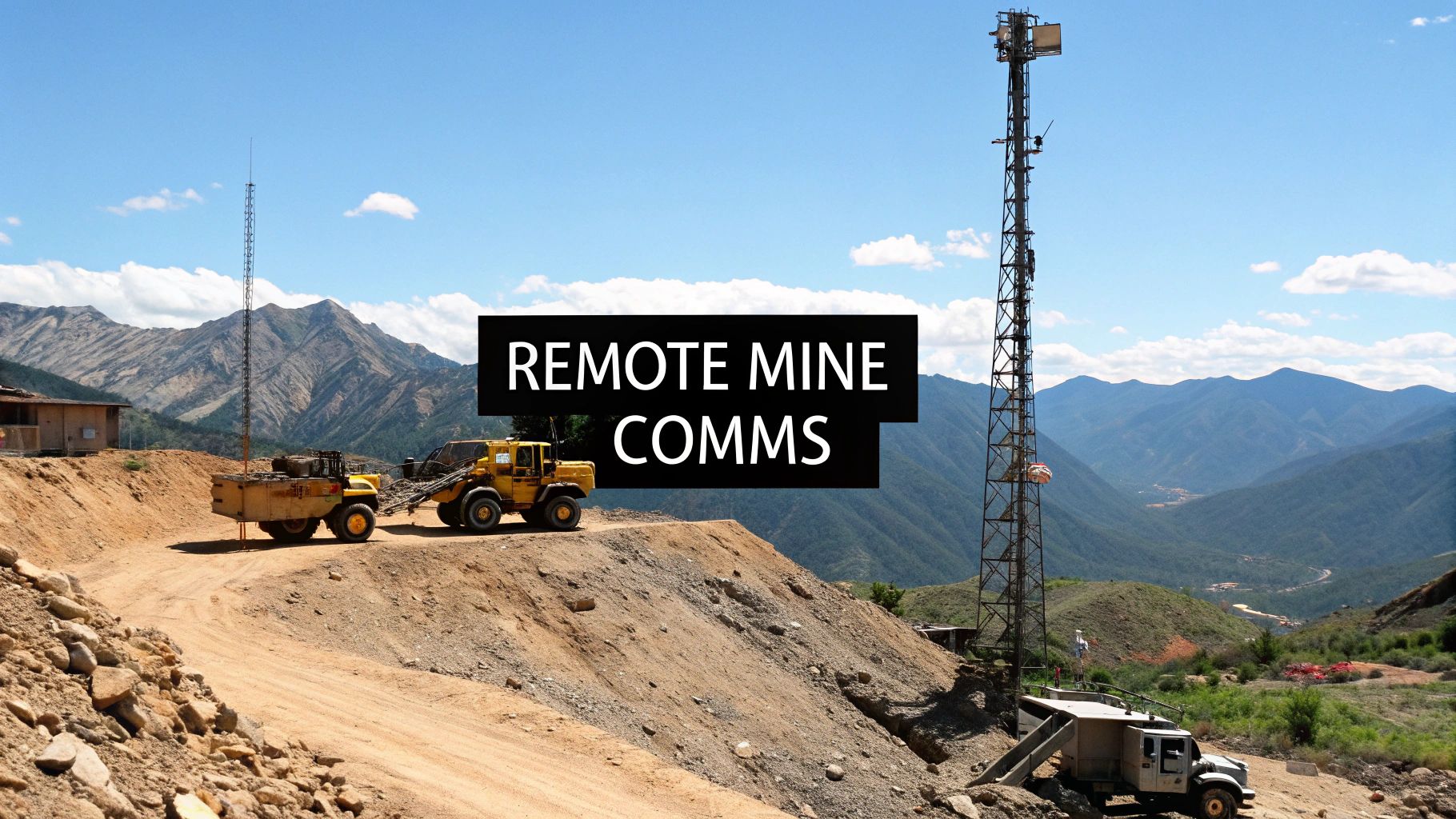Your Guide to NZ-Compliant Portable Traffic Lights
When you're managing a complex worksite, portable traffic lights are far more than just another piece of equipment. They're vital, legally recognised communication devices. Think of them as your tireless, automated sentinels, providing clear and consistent instructions in situations where traditional stop/go signs are either unsafe or just not practical.
Why Portable Traffic Lights Are Essential for NZ Worksites
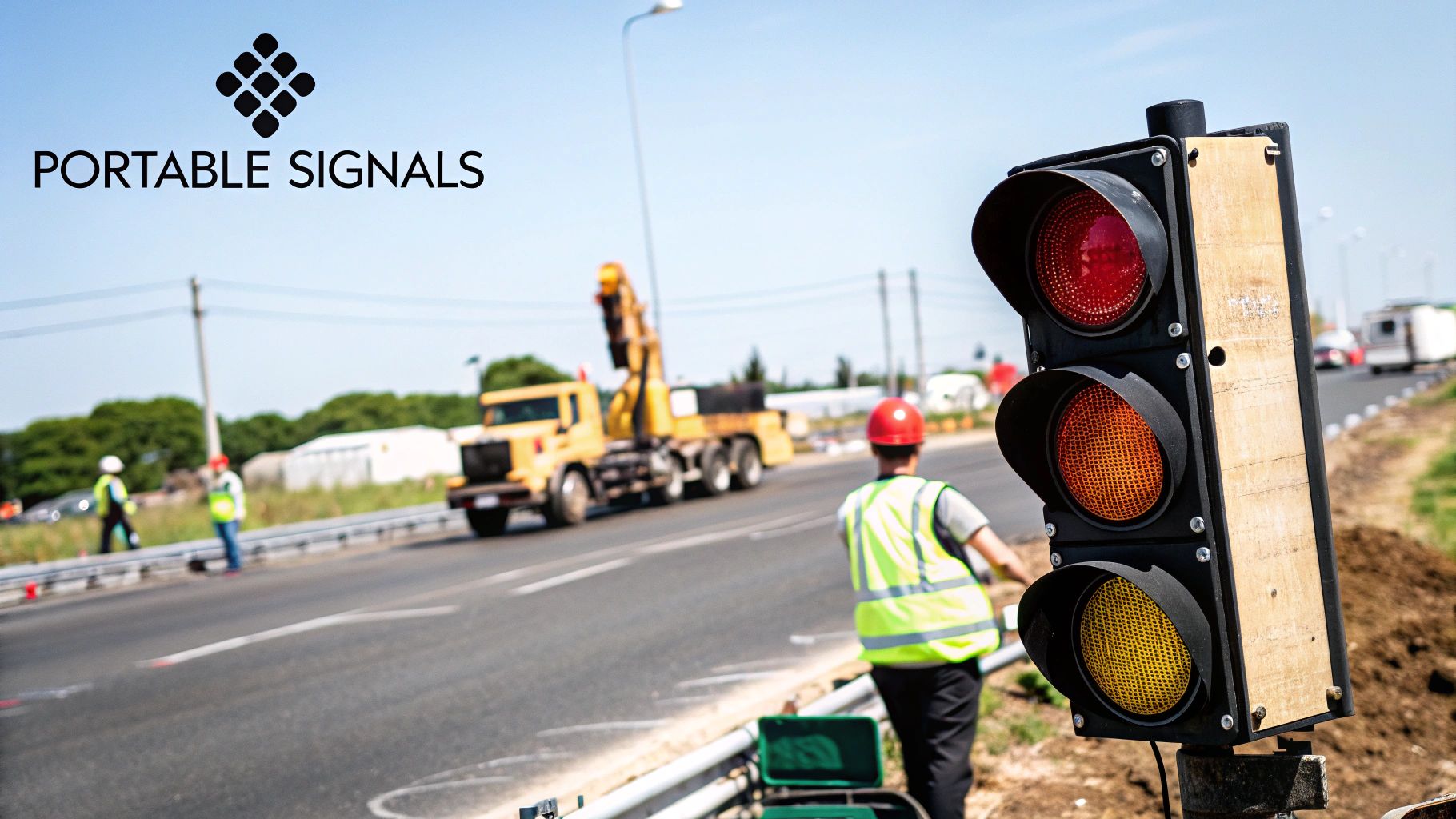
Staring down a worksite plan can feel a bit daunting, but the core mission of traffic management is simple: keep everyone safe. Here in New Zealand, portable traffic lights are the backbone of any compliant and secure temporary traffic setup, playing an absolutely critical role during roadworks, emergency situations, or large-scale events. They're the go-to tool for directing vehicle flow and protecting both your crew and the public.
This focus on professional traffic control isn't a new thing. Temporary traffic management in New Zealand has come a long way since the 1950s. The opening of the country's very first motorway really brought home the growing need for safer, more organised ways to guide vehicles around roadworks, which paved the way for the sophisticated systems we rely on today.
The Modern Role in Worksite Safety
These days, portable traffic light systems are indispensable legal tools. Their job goes well beyond just flashing red and green; they ensure a worksite is locked into strict safety protocols. By automating the flow of traffic, they completely remove the need for human flaggers to stand in live traffic lanes, which dramatically cuts down the risk of serious accidents.
A well-implemented portable traffic light system is a worksite’s first line of defence. It establishes clear, authoritative control over the environment, which is fundamental for preventing incidents and ensuring project efficiency.
They are specifically engineered to be reliable communication devices, giving directives that every single driver instinctively understands. This level of clarity is crucial for maintaining order and preventing confusion, especially in high-stress scenarios like an emergency road closure.
For anyone overseeing a project, getting a handle on the full range of available traffic management solutions is the key to a smooth and successful operation. At the end of the day, these lights aren't just a piece of hardware—they are a core component of any modern, safe, and legally compliant worksite in New Zealand.
How Portable Traffic Lights Communicate
Ever driven through a long stretch of roadworks and wondered how two sets of lights, sometimes kilometres apart, stay in perfect sync? The technology behind portable traffic lights is a clever mix of rugged hardware and smart communication, all designed to keep traffic moving safely and efficiently.
At its core, a portable traffic light system is built from a few key components. You've got the highly visible signal heads (the actual red, amber, and green lights), a smart controller that acts as the brain, and a reliable power source—usually a combination of deep-cycle batteries and solar panels. These pieces work together to create a dependable traffic management tool.
Think of it as a flawless, disciplined conversation between two traffic controllers. Instead of shouting or waving their arms, the two light units talk to each other wirelessly. One unit essentially says to the other, "I'm holding traffic now; it's your turn to let them through," and they switch roles without missing a beat. This constant, synchronised radio signal is what prevents conflicts and makes sure only one direction flows at a time.
The Brains Behind the Operation
The real magic happens inside the controller unit. This is where all the timings, sequences, and cycles are programmed. While basic setups can run on simple timers, the modern systems you'll find across New Zealand are far more intelligent.
These systems are more than just automated timers. They are intelligent legal communication devices that adapt to live conditions, turning a simple stop/go instruction into a responsive traffic solution that minimises frustration and maximises safety.
Advanced portable traffic lights now include smart features like vehicle detection sensors. These sensors, often radar or microwave-based, can tell when vehicles are approaching or waiting at a red light. This lets the system be much more efficient with everyone's time.
For instance, if no cars are waiting at the red, the system can shorten that red phase and give more green time to the active flow of traffic. This kind of adaptability is a game-changer for reducing unnecessary delays, especially during off-peak hours. It moves beyond a rigid, fixed schedule to a system that actually responds to what’s happening on the road.
Key Operational Components
The reliability of these systems comes down to how well their main parts work together. Each component is built tough to handle the demanding conditions of a New Zealand worksite.
- Smart Controllers: These are the central processing units. They contain the logic for traffic cycles, store any custom settings, and manage the crucial wireless link between the signal units.
- Signal Heads: Using ultra-bright, energy-efficient LEDs, these heads have to be perfectly visible in all conditions, from the glare of direct sunlight to pouring rain. Their design is all about maximum clarity for drivers.
- Power Systems: Most modern units run on a hybrid solar-and-battery system. The solar panels keep the batteries topped up during the day, which means many systems can operate for weeks—or even indefinitely—without needing any manual intervention.
- Wireless Radio Link: This is the invisible thread connecting the units. A stable, secure radio link is absolutely critical for synchronised operation, preventing signal dropouts that could lead to dangerous traffic conflicts.
Improving Safety and Efficiency on New Zealand Roads
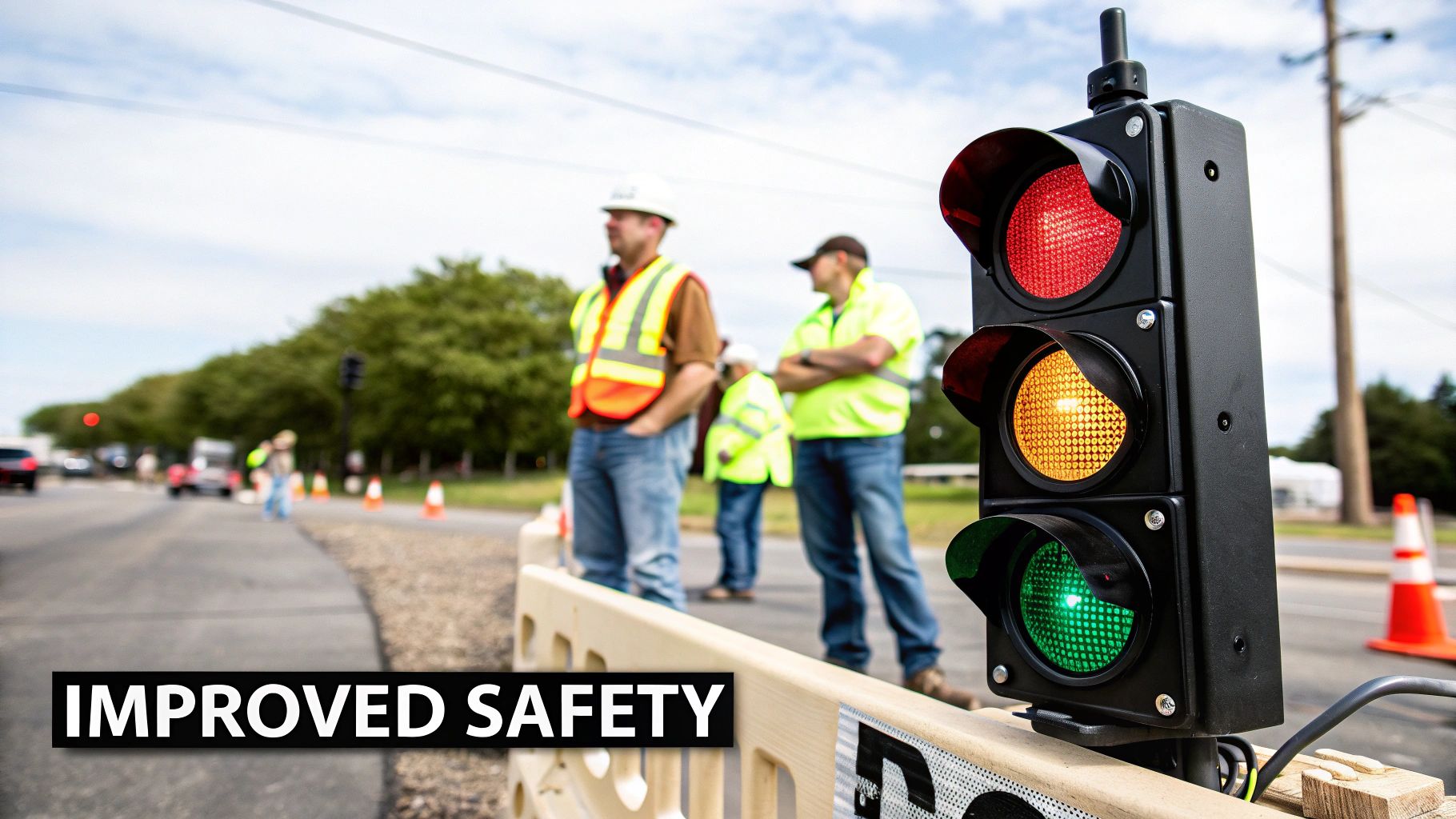
When it comes down to it, any piece of worksite equipment is only as good as the results it delivers. For portable traffic lights, those results are direct and powerful, bringing major improvements to both safety and efficiency on Kiwi roads. The most immediate and obvious impact? A massive boost to worker safety.
By taking over the job of directing traffic, these automated systems get human flaggers out of the direct line of fire. It’s a simple change, but one that dramatically cuts the risk of tragic accidents caused by a moment of driver inattention or poor visibility. Instead of standing just metres from moving vehicles, your crew can manage the site from a much safer position. It’s a critical step forward in protecting our road workers and aligns with the wider goal of improving health and safety everywhere. You can dive deeper into this with our guide on applying road safety within your organisation.
Creating Clearer, Safer Roads
It’s not just about protecting the crew. Portable traffic lights also have a knack for improving driver behaviour. The classic red-amber-green sequence is a language every driver on the planet understands, which gets rid of the confusion that can sometimes happen with manual hand signals. This clarity leads to more predictable, compliant driving – exactly what you need in a temporary traffic zone.
The need for this kind of solid control is highlighted by our national road safety stats. In 2022, New Zealand saw 375 road fatalities, a sobering figure that marks a 21.8% increase since 2012. In that same decade, injury crashes also climbed by 13.1%. Portable traffic lights directly combat these risks by replacing manual stop/go boards with consistent, reliable regulation, especially where roads are narrowed to a single lane.
The core benefit is simple: automated systems don’t get tired, distracted, or misinterpret a situation. They provide constant, reliable vigilance that is impossible for a human to maintain over a long shift, ensuring safety standards never waver.
This unwavering performance is also what unlocks huge gains in efficiency. Your project is no longer held back by the availability or shift length of traffic controllers.
- 24/7 Operations: With solar-assisted power, these lights can run around the clock, day and night. This opens the door for continuous work schedules and helps get the job done faster.
- Reduced Labour Costs: Automating traffic control frees up your people to handle other critical tasks on-site. It’s all about optimising your workforce.
- Consistent Traffic Flow: The smart systems can adapt to traffic volumes, which minimises needless delays for the public and cuts down on congestion around your worksite.
Beyond the immediate safety wins, portable traffic lights play a big part in improving jobsite productivity. By combining better worker protection with streamlined operations, these systems are a proven way to minimise risk and maximise output in any temporary traffic management scenario.
Where Portable Traffic Lights Are Used in New Zealand
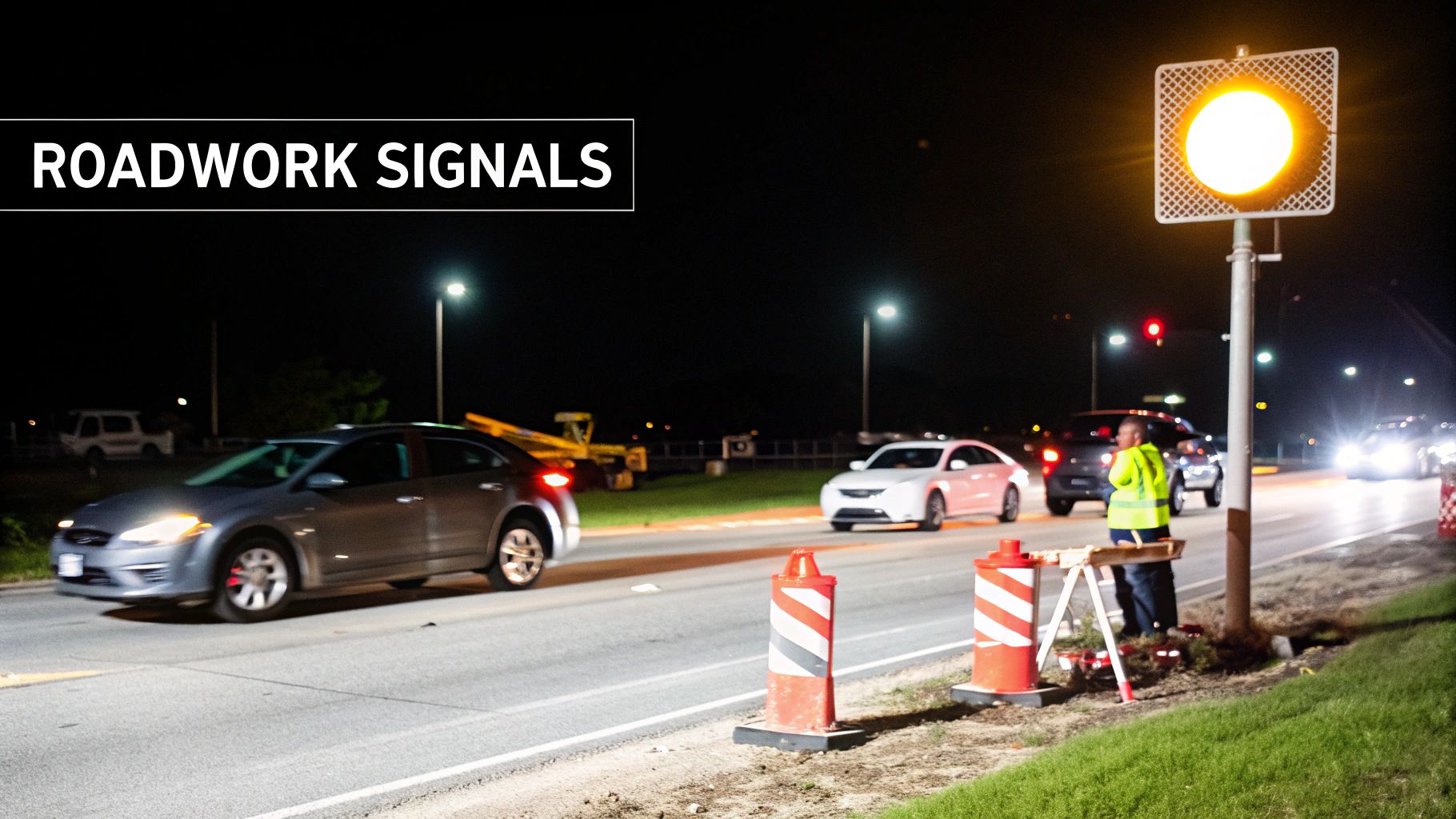
When you picture portable traffic lights, the first thing that probably comes to mind is a standard roadworks site. But their real-world use across New Zealand is much broader and more creative than you might think. These systems are much more than just stop/go signs; they're essential communication tools that solve tricky traffic flow problems in all sorts of situations.
Think about the logistical puzzle of managing vehicles at a huge event like a music festival or an agricultural field day. Getting that volume of traffic in and out safely is a massive undertaking. Portable traffic lights are often brought in to create temporary, controlled intersections and one-way loops, preventing total gridlock and keeping pedestrians safe.
Similarly, after a natural event like a slip or flood, emergency services need to establish safe passage, and they need to do it fast. Portable lights can be deployed in a hurry to manage single-lane access on damaged roads, keeping crucial routes open without the risk of head-on collisions.
Core Applications in Construction and Utilities
Of course, their most common home is within the construction and utilities sectors. This is where they really earn their keep, solving very specific and varied problems.
- Roading and Infrastructure Projects: This is their bread and butter. Whether it’s a quick patch repair or a long-term highway upgrade, these lights are the go-to for managing traffic safely over days, weeks, or even months.
- Utility Maintenance: When crews are down a hole installing new fibre optic cables or fixing a water main, they often need to occupy part of a lane. Portable lights create a safe work bubble for them while letting traffic move past.
- Major Building Sites: Controlling access is vital for large-scale construction. Portable signals can be set up to manage the flow of heavy machinery and delivery trucks, stopping them from conflicting with public traffic.
The true value of portable traffic lights lies in their adaptability. They provide a legally compliant and universally understood method of traffic control that can be applied to almost any situation where temporary flow management is needed.
Specialised and Event-Based Scenarios
Beyond the daily grind of roadworks, these systems prove their worth in more unique situations. You might see them used for a film production that needs to close a street temporarily, or for a community parade that requires traffic diversions.
Portable traffic lights are also indispensable for a wide range of maintenance jobs, like ensuring safety during road grading and leveling projects. In every case, they offer a reliable, automated solution that's safer and often more cost-effective than using multiple human traffic controllers, especially for work that needs to happen after hours. This practical, get-it-done focus is why project managers see them as such a critical and versatile piece of kit.
Choosing the Right Portable Traffic Light System
Picking the right portable traffic light system for your New Zealand worksite can feel like a big decision, but it’s a lot simpler when you know what to look for. The goal is to find a system that’s not just effective and reliable, but also fully compliant and secure, whether you decide to hire or buy.
First things first: legal compliance. In New Zealand, any portable traffic light used on public roads must meet the standards set by Waka Kotahi NZTA. Cutting corners with a non-compliant system isn't just illegal; it opens you up to massive safety and liability risks. Always work with a trusted supplier who can guarantee their gear is up to scratch.
Evaluating Key Technical Features
Once you've ticked the compliance box, it's time to get practical and look at the features that will make or break the system's performance on-site. The power source is a huge one. Many modern systems use a smart hybrid setup, pairing deep-cycle batteries with solar panels. This combination is brilliant for long-term jobs or remote sites, as it allows the lights to run continuously with hardly any hands-on management.
How easy is it to get set up? That's another critical point. A system that needs a whole crew and a complicated process to install just chews through time and money. Look for models designed for a quick, one-person setup—it’s a simple feature that makes a massive difference to your site's efficiency right from day one.
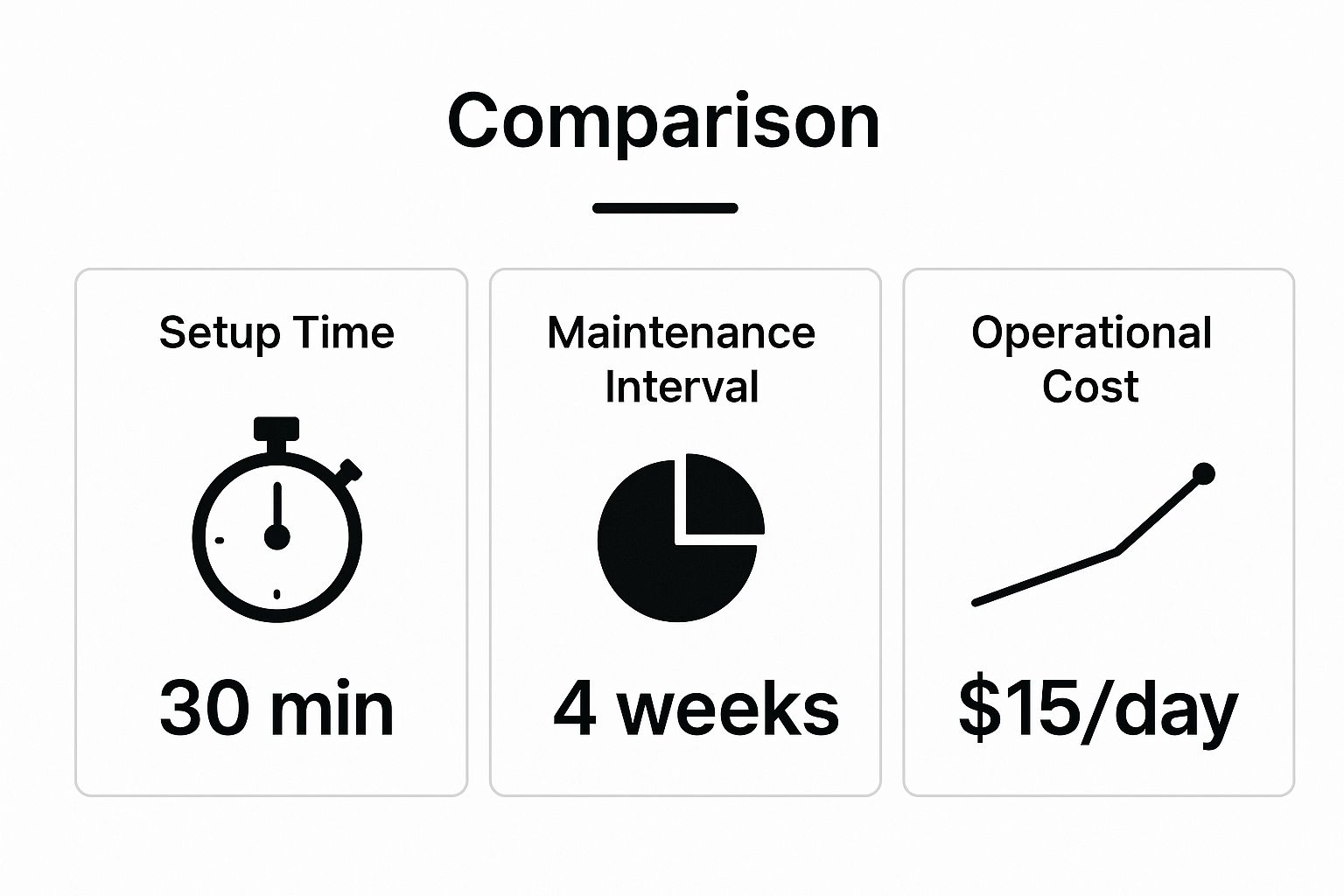
As you can see, the best systems are designed for real-world efficiency, balancing a fast setup with long maintenance cycles and low day-to-day running costs. If your site needs power beyond what's built-in, it's worth checking out the latest best portable generators to keep things running smoothly.
Addressing Security and Durability
Something that’s easy to overlook but incredibly important is the physical security of the units. These are valuable assets left out in public, making them prime targets for theft and vandalism. Unfortunately, theft is a real headache for NZ providers, with some losing around NZ$60,000 a year to stolen gear. When a light goes missing or gets damaged, it creates an immediate danger, like the risk of a head-on collision.
Because of this, leading suppliers have started reinforcing their units with hardened battery boxes and built-in GPS tracking. It’s a direct response to deter thieves and keep our roads safe.
When you're looking at different systems, don't be shy about asking what security features they have. Things like tough construction, lockable battery cases, and GPS tracking aren't just nice-to-haves—they're essential for protecting your gear and keeping your worksite safe and operational.
To help you weigh your options, we've put together this quick comparison table. It highlights the key features you should be thinking about when choosing a portable traffic light system for your next project.
Feature Comparison for Portable Traffic Light Systems
| Feature | Importance Level | What to Look For |
|---|---|---|
| Waka Kotahi NZTA Compliance | Critical | Confirmation that the system is fully compliant with NZTA standards. Ask for documentation. |
| Power Source | High | Hybrid solar and battery systems for long, unattended operation. Check battery life and solar panel efficiency. |
| Ease of Deployment | High | Models designed for quick, one-person setup and transport. Lightweight and simple to configure. |
| Security Features | High | Lockable, reinforced battery enclosures and integrated GPS asset tracking to prevent theft and vandalism. |
| Durability & Weatherproofing | Medium-High | Rugged construction with a high IP rating to withstand rain, wind, and harsh site conditions. |
| Remote Monitoring | Medium | The ability to check status, battery levels, and fault alerts from a web portal or app. |
| Supplier Support | Medium-High | 24/7 technical support, maintenance services, and quick replacement options, especially for hire agreements. |
Choosing the right features from the get-go ensures your traffic management plan runs without a hitch, keeping both your crew and the public safe.
Finally, you'll need to decide whether hiring or buying makes more sense for your business. For one-off jobs or infrequent projects, hiring is usually the smart move because it bundles in maintenance and support. But if your company has a steady pipeline of work, purchasing the equipment could deliver better value in the long run.
For more detailed advice on this, head over to our comprehensive FAQs page, where we tackle many of the common questions that come up.
Got Questions About Portable Traffic Lights? We’ve Got Answers.
Even after seeing all the ways portable traffic lights can streamline a project, you might still have a few practical questions. That’s completely normal. We often hear from project managers and site supervisors across New Zealand who want to get into the nitty-gritty details before they commit.
Getting these details right is what separates a smooth, compliant operation from a problematic one. We're going to tackle the big ones: what the law says, how long they'll run for, and that classic question—should you hire or buy? The goal is to give you the confidence to make the right call for your specific job.
Are Portable Traffic Lights Legal for All NZ Roadworks?
Yes, but there's a huge "if" attached. Any portable traffic light system used on a public road in New Zealand must be fully compliant with Waka Kotahi NZTA standards. This isn't just a guideline; it's a non-negotiable legal requirement.
Using gear that isn't up to spec isn't just illegal, it's a massive safety risk for everyone involved. To keep your project above board and protect your crew and the public, your lights must be part of an approved Temporary Traffic Management Plan (TTMP). The simplest way to tick this box is to partner with a reputable supplier who can show you the paperwork proving their systems are fully compliant.
How Long Can Portable Traffic Lights Run Unattended?
This is a key question, especially for long-term or remote projects, and the answer really depends on the model and its power source.
- Solar-Assisted Systems: Modern units with built-in solar panels are the real game-changers. They can often run indefinitely, as long as they get a few hours of decent sun each day to keep the batteries topped up. They're perfect for "set and forget" situations.
- Battery-Only Models: If you're using a system that relies solely on its internal batteries, you can typically expect it to last anywhere from a few days up to a week before needing a recharge or a quick battery swap.
Before you lock anything in, always ask your supplier about the expected battery life. Making sure it aligns with your project's schedule and maintenance plan will save you from any nasty surprises and unexpected downtime on site.
The big takeaway here is how far power management technology has come. Today's systems are built for autonomy, meaning less time spent on site for your team and more reliable, efficient traffic control.
Should I Hire or Buy Portable Traffic Lights?
This is a business decision, plain and simple. It all comes down to how often your company needs them and what your long-term plans are. There's no single right answer, but here’s a straightforward way to approach it.
Hiring is almost always the best financial move for short-term or one-off projects. A good hire agreement usually bundles in all the maintenance, technical support, and compliance checks, which takes a significant management load off your shoulders.
On the other hand, buying can deliver much better value in the long run if your company is constantly managing jobs that need temporary traffic control. If you go down the purchase route, just be sure to factor in the ongoing costs of storage, regular maintenance, and any potential upgrades needed to stay compliant with future changes to NZTA standards.
At Mobile Systems Limited, we offer a complete range of compliant, reliable portable traffic light systems for both hire and purchase. Our experienced team is here to help you figure out exactly what your project needs to keep your worksite safe and running efficiently.


